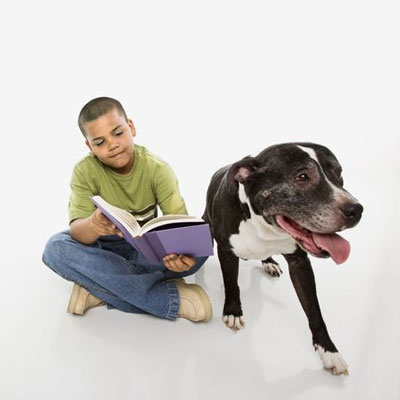
Hello again! We’re into the full swing of celebrating National Poetry Month here at Family Friend Poems, and we’re back with more fun exercises to get you into the spirit of creative expression! To help you through our Thirty Days to Find the Poet in You challenge, we’ve got more Reading to Your Pets exercises!
Quick Review
In the first article in the "Read to Your Pets" series, we focused on two skills that could improve your listener’s experience using your voice to create audio cues. They were:
- Inflection (changing the sound of a word or phrase to convey meaning), and
- Projection (speaking loudly and clearly enough to communicate without explanations).
Using your body to create visual cues
In today’s article we're going to focus on skills that will help you improve your listener’s experience using your body to create visual cues. Once again, these are skills that can be used to improve your experience with poetry and daily life. Just like the other exercises in this series, all you’ll need for these exercises is a patient pet and a poem. Once you’ve got those, we’re ready to roll!
Exercise 1: Stance/Posture
- Find yourself a nice cozy corner and curl yourself into a ball.
Now place the poem in your lap or on your knees and read it out loud.
Feel free to use the techniques that you learned in the last article.
- How does it make you feel to read like this? How would you feel if there was a crowd?
- Does your pet notice you?
- Do you feel a connection to the words you’ve read?
- Grab a chair that has no arms and place it at a table.
Sit on the edge of the chair with your feet beneath the seat and your back straight.
Place the poem on the table in front of you.
Now read the poem out loud.- Does feeling differ from the first reading? If so, how?
- Are you and your pet more or less aware of each other?
- Do you feel more or less connected to the words that you’ve read now?
- Tape the poem to the wall so that it will be eye level when you are standing.
Stand with your feet slightly farther than shoulder width apart and your hands on your hips.
Read the poem out loud a final time.
- How did it feel this time? Would you feel differently about a crowd?
- Has anything changed with your pet?
- Any change with the words that you’ve read?
Both occupying greater space, and standing taller are great ways to increase and project confidence in speaking. These are tools that can be used to portray character. This is not the only way to present poetry (or tell a story, make an argument, give a speech, etc). Intentionally occupying less space is also a valid tool to have in your communication belt.
Exercise 2: Stillness and Movement
- With the poem taped to the wall, read it out loud while standing or sitting perfectly still.
Pay special attention to your eyebrows, head, and hands.
- Are there any little movements that you find particularly difficult to avoid (tapping your fingers, nodding your head, shifting your weight, etc)?
- Think back on the way that you read the poem the first time.
- Notice how difficult it is to keep your head, possibly your hands still while you’re speaking.
- Now read the poem a second time, this time assigning a gesture to each line.
- What physical thing can you do to represent each thought that you read?
- Do you get a reaction from your pet this time?
- Are there places where movement felt needed? Inappropriate?
- Finally, read the poem a third time this time only use the gestures from part 2 that felt like they added some meaning to the phrases that they accompanied.
- Were there any big gestures that you decided to keep? Why?
- Did your pet look at you more or less during this reading? Any big reactions?
- Do you feel like the speaker’s intention
Movement is a wonderful part of human communication, and you’ll see this utilized in many forms of spoken word and slam poetry. You’ll also note moments of stillness. Stillness is notable because we are constantly moving, and it requires intention. It can be a very powerful tool when utilized properly.
Give it a Try!
Here are a few fantastic poems to use for these exercises:
- “Still I Rise” by Maya Angelou
- “Solitude” by Ella Wheeler Wilcox
- “Human Family” by Maya Angelou
- “The Invitation” by Oriah Mountain Dreamer
Have fun reading to your pets! Let us know if anything fun and unexpected happens. Do you have a way of engaging with poetry that we haven’t mentioned yet? Did you have a great experience using these techniques on others? Let us know in the comments!
 Poems On Creativity
Poems On Creativity Sonnets
Sonnets Basic Poetic Techniques
Basic Poetic Techniques How To Write Poetry
How To Write Poetry Teaching Poetry
Teaching Poetry Advanced Poetic Techniques
Advanced Poetic Techniques